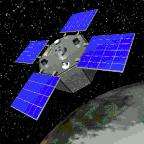ACRIMSAT
 ACRIMSAT | |
| Mission type | Solar astronomy |
|---|---|
| Operator | NASA / JPL |
| COSPAR ID | 1999-070B |
| SATCAT № | 26033 |
| Website |
acrim |
| Mission duration | 7 years |
| Spacecraft properties | |
| Manufacturer | Orbital Sciences |
| Launch mass | 288 kilograms (635 lb) |
| Power | 80.0 watts |
| Start of mission | |
| Launch date | 20 December 1999, 07:13 UTC |
| Rocket | Taurus 2110 |
| Launch site | Vandenberg LC-576E |
| Contractor | Orbital Sciences |
| End of mission | |
| Last contact | 14 December 2013 |
| Orbital parameters | |
| Reference system | Geocentric |
| Regime | Sun-synchronous |
| Semi-major axis | 7,067.28 km (4,391.40 mi) |
| Eccentricity | 0.0029721 |
| Perigee | 675 km (419 mi) |
| Apogee | 717 km (446 mi) |
| Inclination | 97.80 degrees |
| Period | 98.54 minutes |
| Epoch | 5 December 2013, 12:18:57 UTC[1] |
The Active Cavity Radiometer Irradiance Monitor Satellite, or ACRIMSAT is a dedicated satellite and instrument that was one of the 21 primary observational components of NASA's Earth Observing System program. ACRIMSAT was launched on 20 December 1999 from Vandenberg Air Force Base as the secondary payload on a Taurus rocket along with KOMPSAT. It was placed into a high inclination, 700 km. sun-synchronous orbit from which the ACRIM3 instrument monitored total solar irradiance (TSI).[2] Contact with the satellite was lost on 14 December 2013.[3]
History
ACRIM3 made measurements of the TSI since the start of its mission in April 2000. It extended the TSI measurement database begun by earlier ACRIM instruments on the NASA Solar Maximum Mission (ACRIM1: 1980-1989) and Upper Atmosphere Research Satellite (ACRIM2: 1991-2001).
ACRIMSAT/ACRIM3 tracked TSI during a 2004 transit of Venus and measured the 0.1% reduction in the solar intensity caused by the planet's shadow.[4] It also recorded data for the 2012 Transit of Venus.[5]
On 14 December 2013, ACRIMSAT went silent, with attempts to reestablish contact proving unsuccessful. The mostly likely cause has been attributed to the failure of aging batteries. The defunct spacecraft will remain in orbit for approximately 64 years before returning to Earth.[3]
Team
Richard C. Willson was the principal investigator and led the science team.[6] Willson designed the active cavity radiometer type of sensor used by self-calibrating satellite TSI monitoring experiments. The ACRIM3 instrument was a collaboration between Willson, original JPL/ACRIMSAT Project Manager Ronald Zenone and ACRIM3 Instrument Scientist Roger Helizon. The Mission is controlled using the ACRIMSAT tracking station at the Jet Propulsion Labs (JPL) Table Mountain Observatory in Southern California. Co-Investigators are: Nicola Scafetta (climate impact of solar variability), Hugh Hudson (solar physics)and Alexander Mordvinov (solar physics).
Technology
ACRIMSAT (international designator 1999-070B) is a spin-stabilized, single-purpose satellite constructed by Orbital Sciences Corporation. Its total cost, including the instrument, launch, ground station, operations and science team activities during its 14-year mission was less than $50 million.
References
- ↑ "ACRIMSAT Satellite details 1999-070B NORAD 26033". N2YO. 5 December 2013. Retrieved 6 December 2013.
- ↑ Composite TSI Time Series
- 1 2 "Sun sets for a NASA solar monitoring spacecraft." Jet Propulsion Laboratory. Retrieved: 9 August 2015.
- ↑ Schneider, G.; Pasachoff, J. M.; Willson, Richard C. (2006). "The Effect of the Transit of Venus on ACRIM's Total Solar Irradiance Measurements: Implications for Transit Studies of Extrasolar Planets". The Astrophysical Journal (641): 565–571. doi:10.1086/500427.
- ↑ "Catalog Page for PIA15820". nasa.gov.
- ↑ "ACRIM Staff Information". acrim.com. Retrieved 2015-07-25.
External links
- AcrimSat Launch
- ACRIM Science Team homepage
- ACRIMSAT Project homepage
- Fact sheet on the mission
- ACRIMSAT: NASA Science Missions

